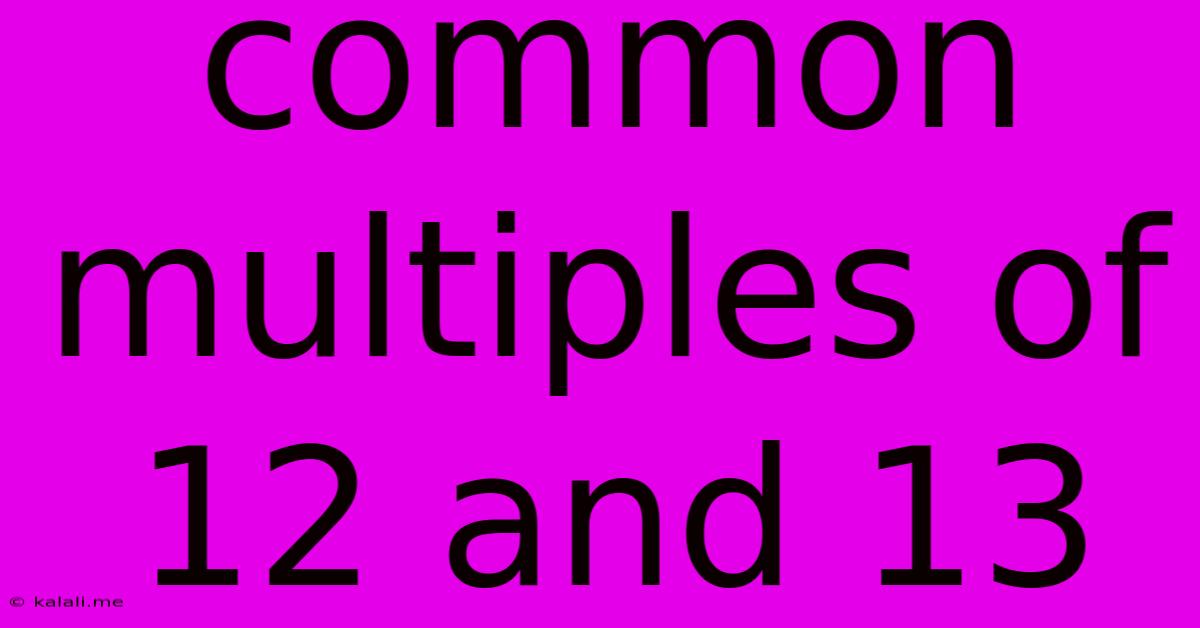Common Multiples Of 12 And 13
Kalali
Jun 15, 2025 · 3 min read

Table of Contents
Unveiling the Secrets of Common Multiples: 12 and 13
Finding the common multiples of 12 and 13 might seem like a daunting task at first, but with a clear understanding of the underlying mathematical concepts, it becomes surprisingly straightforward. This article will guide you through the process, explaining the core principles and offering practical methods for determining these multiples. Understanding common multiples is crucial for various mathematical applications, from simplifying fractions to solving complex equations. Let's dive in!
What are Common Multiples?
Before tackling the specifics of 12 and 13, let's establish a solid foundation. A multiple of a number is the product of that number and any integer (whole number). For example, multiples of 12 include 12, 24, 36, 48, and so on. A common multiple is a number that is a multiple of two or more numbers simultaneously. For instance, 12 and 18 share common multiples such as 36, 72, and 108.
Finding Common Multiples of 12 and 13: A Step-by-Step Guide
-
List the Multiples: The most straightforward, albeit potentially time-consuming for larger numbers, method is listing the multiples of each number individually. Begin by listing the multiples of 12: 12, 24, 36, 48, 60, 72, 84, 96, 108, 120, 132, 144, 156... and the multiples of 13: 13, 26, 39, 52, 65, 78, 91, 104, 117, 130, 143, 156...
-
Identify the Overlap: Now, carefully examine both lists. Look for numbers that appear in both sequences. The first common multiple you'll notice is 156.
-
Understanding the Least Common Multiple (LCM): The smallest common multiple is called the Least Common Multiple (LCM). In this case, the LCM of 12 and 13 is 156. All other common multiples will be multiples of the LCM.
A More Efficient Method: Using Prime Factorization
For larger numbers, listing multiples can become impractical. A more efficient method involves prime factorization.
-
Prime Factorize: Find the prime factors of each number:
- 12 = 2 x 2 x 3 (2² x 3)
- 13 = 13 (13 is a prime number)
-
Construct the LCM: To find the LCM, take the highest power of each prime factor present in either factorization and multiply them together. In this case, we have 2², 3, and 13.
LCM(12, 13) = 2² x 3 x 13 = 4 x 3 x 13 = 156
This confirms that 156 is indeed the LCM of 12 and 13. All other common multiples will be multiples of 156 (312, 468, 624, and so on).
Practical Applications
Understanding common multiples is essential in various mathematical contexts:
- Fraction Addition and Subtraction: Finding a common denominator when adding or subtracting fractions involves finding a common multiple of the denominators.
- Scheduling and Pattern Recognition: Identifying recurring events or patterns often relies on understanding common multiples. For example, if Event A happens every 12 days and Event B happens every 13 days, they will coincide every 156 days.
This comprehensive guide provides you with the necessary tools and understanding to confidently determine the common multiples of 12 and 13, as well as a broader grasp of this fundamental mathematical concept. Remember, practice makes perfect! Try finding the common multiples of other number pairs to solidify your understanding.
Latest Posts
Latest Posts
-
How To Create A Joint Probability Table
Jun 15, 2025
-
What Organelles Contain Their Own Dna
Jun 15, 2025
-
Stevens Institute Of Technology Average Sat
Jun 15, 2025
-
Moment Of Inertia Of A T Section
Jun 15, 2025
-
What Is The Prime Factorization Of 216
Jun 15, 2025
Related Post
Thank you for visiting our website which covers about Common Multiples Of 12 And 13 . We hope the information provided has been useful to you. Feel free to contact us if you have any questions or need further assistance. See you next time and don't miss to bookmark.